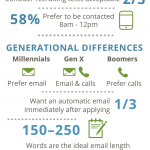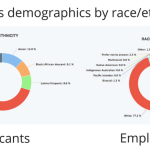What I’ve Learned By Hiring More Employees With Disabilities
Everyone deserves a chance to succeed. And by my estimation, no group has been refused that opportunity more than people living with disabilities (PLWD). Sadly, less than one-fifth of this population is employed.
Even though I’ve made expanding opportunities for PLWD my life’s work, I nearly denied my first PLWD hire, Andrew, a fair shake. My company sells wine and donates all profits to nonprofits, so we host tastings at grocery and liquor stores. Now one of my top employees, Andrew began his first tasting in 2015 like a pushy car salesman.
Within minutes, I was reconsidering my hire, anxiously coaching him between interactions. And something happened that, in hindsight, I should’ve expected: Andrew listened to me, improving his approach with each customer. After all, nobody gets a new job right on the first shot. By tasting’s end, customers were lining up to speak with Andrew. We wound up selling twice our normal volume that day.
Something else happened, too. I discovered the true value of employing PLWD—not as token employees but as real members of my team. Now, three of my 10 employees are PLWD, and as I’ve learned, integrating PLWD into a workforce takes a little finesse but is well worth the effort. If you’re an entrepreneur or business leader, these are a few ways you can hire and prepare PLWD to become some of your most indispensable employees.
1. Start With An Introductory Program
On Andrew’s first day, I mistakenly threw him into the fire with little preparation. Instead, take some time and care with the on-boarding process. You can even progressively acclimate newly hired PLWD through internships, on-location work trials, or job shadowing. The Institute for Corporate Productivity (i4cp) found that nearly three-quarters of employers participating in these programs saw positive results; only 8% said support needs were greater than anticipated.
In 2009, AMC Entertainment began hiring PLWD. To integrate its new talent, the theater chain collaborated with the Autism Society in Bethesda, Maryland. When asked about the program’s results, AMC’s chief people officer told Bloomberg, “You end up being a healthier company from a lot of different perspectives: innovation, engagement, morale, productivity.”
So while your crew flourishes because of your inclusion program, rest assured knowing your company will benefit, too. The i4cp study found that employing PLWD increased customer satisfaction by 44% and enhanced brands by 34%.
2. Find The Best Fit
As is true for any employee, PLWD on your team thrive when their roles match their skills. Fortunately, PLWD have succeeded across employment categories, including administrative work, facility maintenance, food service, and patient care.
If you’re not sure which roles within your organization might work for PLWD, contact local agencies that specialize in connecting employers with PLWD candidates. While the U.S. Equal Employment Opportunity Commission forbids discrimination—positive or negative—based on disability, these agencies can recommend PLWD candidates who might fit with open roles. St. Louis Arc, for example, pointed me toward Andrew as a candidate for wine tastings. I’ve also received great recommendations from the St. Louis–based United Cerebral Palsy Heartland and The Center for Head Injury Services.
If you choose to hire a PLWD, consider customized employment. A Seattle man with disabilities, whom I’ll call John, and his employer tapped into his full potential using this approach.
Once a low-wage workshop employee, John told Carol Salter, who works for a disability advocacy organization, that he wanted to build engines. Carol knew John couldn’t earn the necessary certifications for the job, but as she watched mechanics hauling equipment, breaking down boxes, and cleaning spills, Salter realized John could tackle these tasks. Now John makes $11 per hour as an essential member of the shop, allowing higher-paid specialists to spend more time fixing engines.
3. Question Preconceptions At Every Turn
We all like to think we’re sensitive and self-aware, but it takes constant vigilance to see how unconscious biases color our perceptions of others. Just as I reacted poorly to Andrew’s initial performance, too many employers see inability before giving PLWD a chance.
Mercy Healthcare, a local leader in hiring PLWD, earned my support by demonstrating how biases unfairly restrict this population. In one exercise, Mercy’s facilitators showed photographs of individuals and asked participants what jobs they appeared qualified for. Unsurprisingly, some highly educated PLWD were judged to be unfit for the very roles they were working in. Our first instincts can often be wrong, and that limits both employers and employees.
4. Praise With Honesty And Precision
Complimenting somebody for working as expected isn’t the same as celebrating a serious accomplishment. Consider how insulted you’d feel if you were told, “Congratulations, you met expectations.” Instead, acknowledge specific significant achievements, such as “You’ve packaged more parts than anyone on the floor this month, John. That’s a big deal.”
The late Stella Young, a disability rights activist known for her journalism and comedy, took aim in a TEDx Talk at the way PLWD are praised for minor efforts, such as simply going to work—arguing that modern culture (especially in the social-media age) patronizingly holds up disability as a source of inspiration for those who don’t experience it.
Academic and PLWD Tom Shakespeare says this occurs because perceptions of the community are so low to begin with. By praising only when it’s truly deserved—much as you would any employee—we can break that mindset. In fact, we need to in order to integrate more PLWD meaningfully not just into the workplace and, hopefully, build a more inclusive society in the process.
But remember: While employing PLWD can make your company look good, the initiative can’t be about appearances. Top-performing companies, as i4cp found in its research, don’t hire PLWD for positive press or compliance. They do it—successfully—as a competitive strategy.
Including PLWD in your workforce can benefit your bottom line, but it’s all in the way you do it. And who knows? You may even find your own Andrew.
Scott Monette is the founder of 100 Percent Wine, a premium winery based in St. Louis that produces California wine. The company donates all profits to nonprofit organizations working to create jobs for people living with disabilities. Previously the chief financial officer for Ralcorp Holdings, Scott is now a dedicated father, entrepreneur, and philanthropist.
Fast Company , Read Full Story
(17)














